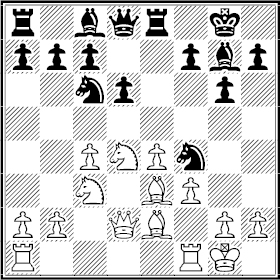
Blunders are in the air when you fail to take an opponent’s advanced piece seriously.
Marco Pacheco White
Axel Bachmann Schiavo Black
Turin 2006
King’s Indian Defense, Classical Variation E94
1 d4 ♘f6 2 ♘f3 g6 3 c4 ♗g7 4 ♘c3 0-0 5 e4 d6 6 ♗e2 e5 7 0-0
White cannot win a pawn with 7 dxe5 dxe5 8 ♕xd8 ♖xd8 9 ♘xe5? because of the desperado 9...♘xe4!. He would be worse after 10 ♘xe4 ♗xe5 11 0-0 ♘c6 – and much worse after 10 ♘xf7? ♗xc3+ 11 bxc3 ♔xf7.
7...exd4 8 ♘xd4 ♘c6! 9 ♗e3
Black’s use of the b-file offsets his doubled pawns after 9 ♘xc6 bxc6 (10 ♗e3 ♖e8 11 ♗f3 ♖b8).
9...♖e8 10 f3 ♘h5!
Too slow for equality is 10...♘e5 (11 ♕d2 c6 12 ♖ad1).
Instead, Black’s idea is ...♘f4, e.g. 11 g4 ♘xd4 12 ♗xd4 ♗xd4+ 13 ♕xd4 ♘f4! with a nice game. Alternatively 11 f4 ♘f6 (12 ♘xc6?! bxc6 13 ♗f3 ♘xe4! 14 ♘xe4 ♗f5 or 14 ♗xe4 d5).
11 ♕d2 ♘f4!
Now 12 ♗xf4 ♘xd4 or 12 ♘xc6 ♘xe2+ 13 ♘xe2 bxc6 is fine for Black.

12 ♖fe1??
White fails to give the f4-knight proper concern. He would still have a fine game after, say, 12 ♖fd1.
12...♗xd4! White resigns.
In view of 13 ♗xd4 ♕g5! followed by 14...♕xg2 mate or 14...♘h3+ and 15 ...♕xd2.
An earlier game saw 11...♘xd4 12 ♗xd4 ♘f4 13 ♗xg7.
Question 222: What’s wrong with that?
Marcel Peek White
Chris De Saegher Black
Amsterdam 2002
1 d4 ♘f6 2 ♘f3 g6 3 c4 ♗g7 4 ♘c3 0-0 5 e4 d6 6 ♗e2 e5 7 0-0 exd4 8 ♘xd4 ♖e8 9 f3 ♘c6 10 ♗e3 ♘h5 11 ♕d2 ♘f4 12 ♖fd1 ♘xd4 13 ♗xd4 ♘xe2+ 14 ♘xe2 ♕e7 15 ♘c3 f5 16 ♘d5 ♕f7 17 ♗xg7 ♔xg7? 18 ♕c3+! ♔h6 19 exf5 ♗xf5 20 g4! c6 21 g5+! ♔xg5? 22 ♕d2+ ♔h5 23 h4 h6 24 ♘f4+ ♔xh4 25 ♔f2 ♗g4 26 ♘g2+! resigns.